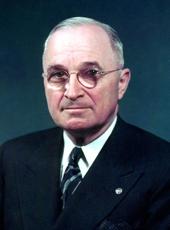[Broadcast from the White House at 11:45 p.m.]
Fellow Americans:
Again it is my privilege to speak to you about a movement that should have the heartfelt support of all of us. I refer to the continuing fight against the scourge of infantile paralysis.
Franklin D. Roosevelt, himself a victim of the disease, saw the need for an organization to wage the fight, and so, in 1938, he brought into being the National Foundation for Infantile Paralysis. We can do our part by giving to the March of Dimes. The National Foundation, supported by your gifts, reaches into every corner of the country to find and help the stricken.
Let me show you by an example what the National Foundation for Infantile paralysis has achieved.
Within 30 years there have been two appalling epidemics of the disease in the United States. The first epidemic, raging chiefly along the eastern seaboard, caught the country unprepared. There was not enough help, not enough knowledge; no one knew what to do. The poor suffered most, not because infantile paralysis strikes more often among the poor, but because those cases lacked funds for medical care. As the total cases mounted, panic spread; fantastic cures were advertised, for sale and not for sale. The total of dead for that epidemic was more than 20 percent of the victims, most of whom were young children. And most of those who survived were permanently crippled.
The second of the two epidemics struck last year--first in Florida, then in Alabama, Texas, Minnesota, Colorado, Missouri, Kansas, the Dakotas, Wisconsin, California, Illinois, and all along the Mississippi Valley. Last year the disease was more widespread. The cost of treating the stricken had risen very high--but thousands achieved complete recovery, and only 5 percent died.
The country, this time, was not caught unprepared. The National Foundation for Infantile Paralysis had educated the public in knowledge of the disease. Doctors knew what to do--and not only doctors but nurses and physical therapists--because the National Foundation had financed training for personnel at many hospitals and universities throughout the land. The poor did not suffer most, because the National Foundation was ready, through its county chapters, to provide funds for the care and treatment of every victim. There was no shortage of medical experts, equipment, supplies, or funds even in the hardest hit areas, because into those areas the National Foundation rushed extra help of every kind.
No organization but a great national nonprofit organization could have handled so huge a task. In coming to our rescue through last year's epidemic, the National Foundation exhausted its funds from the 1946 March of Dimes and drew heavily upon its resources. The millions spent last year on medical care and treatments, on research and education, must be replaced if the fight is to go on.
If there is one of you who has not yet joined the March of Dimes, I urge you to go now and enlist.
Harry S Truman, Radio Remarks on Behalf of the March of Dimes Campaign. Online by Gerhard Peters and John T. Woolley, The American Presidency Project https://www.presidency.ucsb.edu/node/232173


